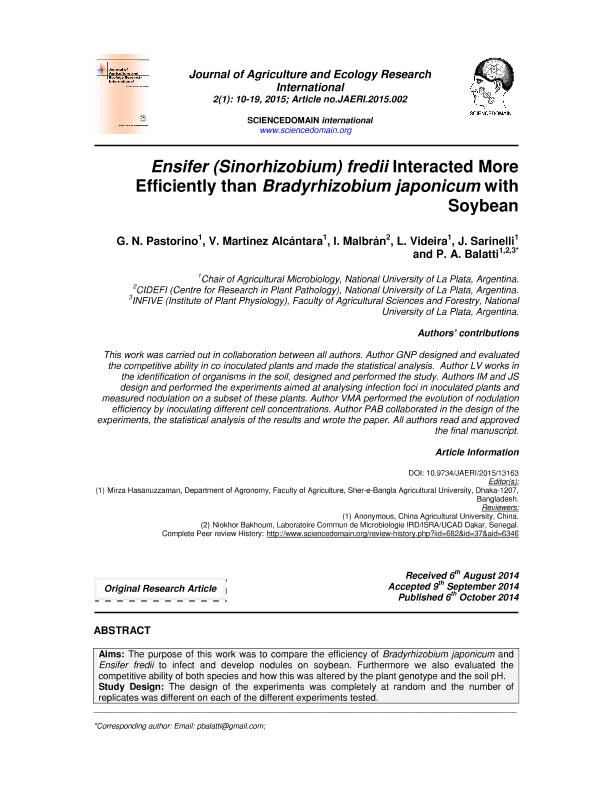Mostrar el registro sencillo del ítem
dc.contributor.author
Pastorino, Graciela Noemí

dc.contributor.author
Martínez Alcántara, Virginia

dc.contributor.author
Malbrán, Ismael

dc.contributor.author
Videira, L.
dc.contributor.author
Sarinelli, J.
dc.contributor.author
Balatti, Pedro Alberto

dc.date.available
2018-06-22T19:49:15Z
dc.date.issued
2015-01
dc.identifier.citation
Pastorino, Graciela Noemí; Martínez Alcántara, Virginia; Malbrán, Ismael; Videira, L.; Sarinelli, J.; et al.; Ensifer (Sinorhizobium) fredii Interacted More Efficiently than Bradyrhizobium japonicum with Soybean; Science Domain International; Journal of Agriculture and Ecology Research International; 2; 1; 1-2015; 10-19
dc.identifier.issn
2394-1073
dc.identifier.uri
http://hdl.handle.net/11336/49738
dc.description.abstract
Aims:The purpose of this work was to compare the efficiency of Bradyrhizobium japonicum and Ensifer fredii to infect and develop nodules on soybean. Furthermore we also evaluated the competitive ability of both species and how this was altered by the plant genotype and the soil pH. Study design: The design of the experiments was completely at random and the number of replicates was different on each of the different experiments tested. Place and Duration of Study: Department of Medicine (Medical Unit IV) and Department of Radiology, Services Institute of Medical Sciences (SIMS), Services Hospital Lahore, between June 2009 and July 2010. The whole work lasted about a year and a half. Methodology: Roots of inoculated soybean plants were fixed and the number of infection initiation sites was evaluated by means of microscopic observation. The number of nodules developed by inoculated plants was also evaluated. Results: Bacteria were equally effective at developing infection initiation sites on soybean however, E. fredii induced more nodules than B. japonicum, probably due to the fact that E. fredii is more efficient than B. japonicum at nodulating soybean. However, Bradyrhizobium was more competitive than E. fredii which was unrelated to the soybean genotype but altered by the soil pH. Under the conditions described E. fredii was less competitive than B. japonicum probably due to the high cultivar-rhizobia specificity. Conclusion: Therefore, we concluded that E. fredii was as efficient as B. japonicum at nodulating soybeans. However Bradyrhizobium was a better competitor though this is affected by the plant genotype and the soil pH. The selection and use of fast growing rhizobia in inoculant production seems to depend on broadening the genetic base of soybean or in selecting cultivars with specificity for fast growing rhizobia.
dc.format
application/pdf
dc.language.iso
eng
dc.publisher
Science Domain International
dc.rights
info:eu-repo/semantics/openAccess
dc.rights.uri
https://creativecommons.org/licenses/by-nc-sa/2.5/ar/
dc.subject
Bradyrhizobium
dc.subject
Ensifer Fredii
dc.subject
Nodulation
dc.subject
Competition
dc.subject.classification
Otras Ciencias Biológicas

dc.subject.classification
Ciencias Biológicas

dc.subject.classification
CIENCIAS NATURALES Y EXACTAS

dc.title
Ensifer (Sinorhizobium) fredii Interacted More Efficiently than Bradyrhizobium japonicum with Soybean
dc.type
info:eu-repo/semantics/article
dc.type
info:ar-repo/semantics/artículo
dc.type
info:eu-repo/semantics/publishedVersion
dc.date.updated
2018-05-21T14:38:55Z
dc.journal.volume
2
dc.journal.number
1
dc.journal.pagination
10-19
dc.journal.pais
India

dc.description.fil
Fil: Pastorino, Graciela Noemí. Universidad Nacional de La Plata; Argentina. Consejo Nacional de Investigaciones Científicas y Técnicas; Argentina
dc.description.fil
Fil: Martínez Alcántara, Virginia. Universidad Nacional de La Plata; Argentina
dc.description.fil
Fil: Malbrán, Ismael. Universidad Nacional de la Plata. Facultad de Ciencias Agrarias y Forestales. Departamento de Ciencias Biológicas. Centro de Investigaciones de Fitopatología. Provincia de Buenos Aires. Gobernación. Comision de Investigaciones Científicas. Centro de Investigaciones de Fitopatología; Argentina
dc.description.fil
Fil: Videira, L.. Universidad Nacional de La Plata; Argentina
dc.description.fil
Fil: Sarinelli, J.. Universidad Nacional de La Plata; Argentina
dc.description.fil
Fil: Balatti, Pedro Alberto. Universidad Nacional de la Plata. Facultad de Ciencias Agrarias y Forestales. Departamento de Ciencias Biológicas. Centro de Investigaciones de Fitopatología. Provincia de Buenos Aires. Gobernación. Comision de Investigaciones Científicas. Centro de Investigaciones de Fitopatología; Argentina. Consejo Nacional de Investigaciones Científicas y Técnicas. Centro Científico Tecnológico Conicet - La Plata. Instituto de Fisiología Vegetal. Universidad Nacional de La Plata. Facultad de Ciencias Naturales y Museo. Instituto de Fisiología Vegetal; Argentina
dc.journal.title
Journal of Agriculture and Ecology Research International
dc.relation.alternativeid
info:eu-repo/semantics/altIdentifier/doi/http://dx.doi.org/10.9734/JAERI/2015/13163
dc.relation.alternativeid
info:eu-repo/semantics/altIdentifier/url/http://www.sciencedomain.org/abstract/6346
Archivos asociados
